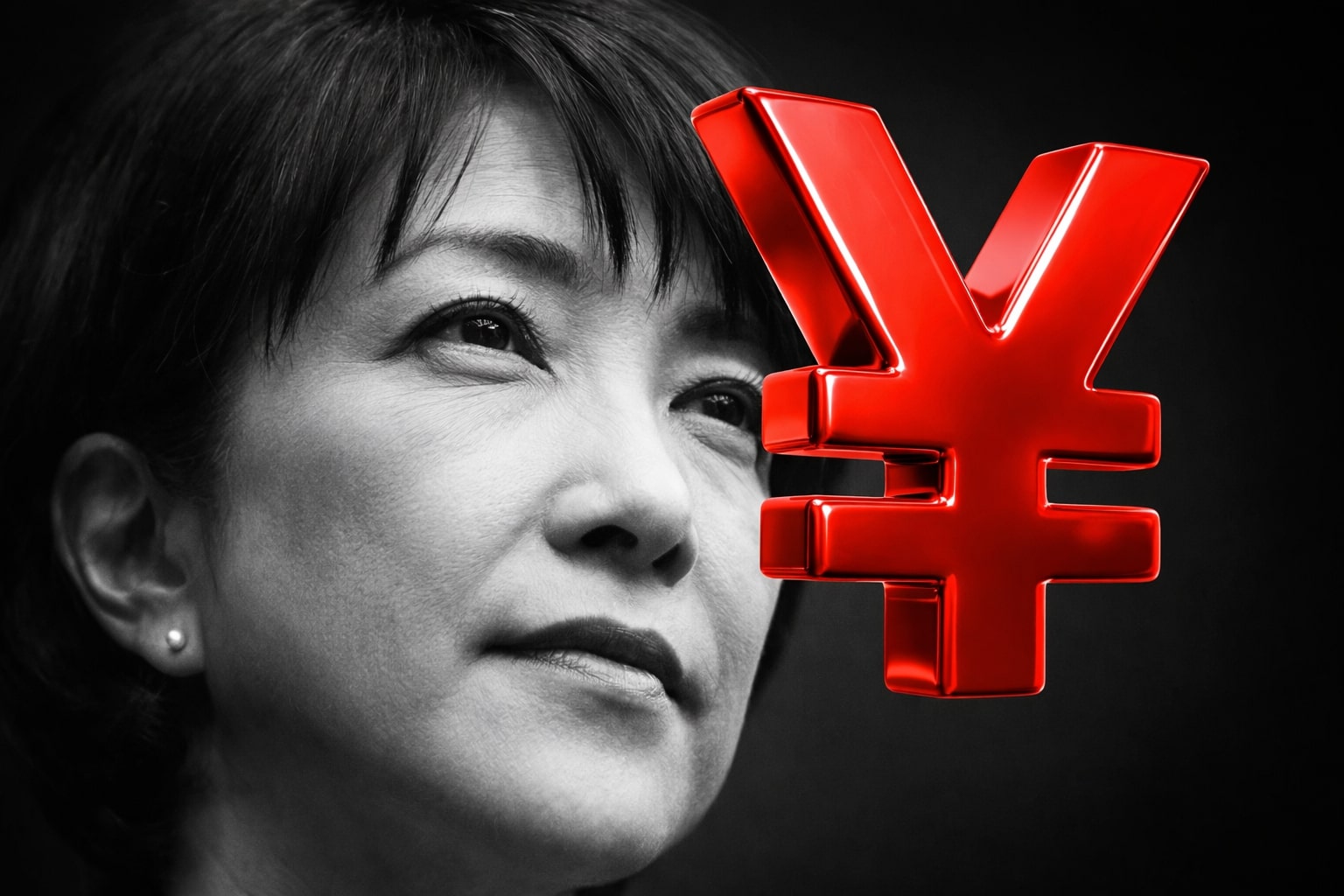
USD/JPY Price Forecast - Yen Holds Near 154.00 as Yen Slides and Market Awaits Fed-BoJ Policy Shift
The Japanese Yen remains pressured as the BoJ delays rate hikes and Tokyo plans a new ¥12 trillion stimulus, while weak U.S. jobs data lifts expectations for a Fed cut in December | That's TradingNEWS
USD/JPY (Dollar/Yen) Holds Near 154.00 as Market Awaits Breakout Signal
The USD/JPY pair remains locked near 154.00, consolidating just below the major resistance band of 154.50–155.00, as traders digest weak U.S. labor data and the Bank of Japan’s (BoJ) cautious policy stance. The dollar initially rallied to a fresh nine-month high at 154.50, before retracing as softer U.S. employment numbers reinforced expectations of a Federal Reserve rate cut in December. According to the CME FedWatch Tool, markets now assign a 70% probability of a 25-basis-point cut next month, up from 62% a day earlier. The U.S. Dollar Index (DXY) slipped to 99.40, marking its fifth consecutive daily decline.
BoJ’s Reluctance to Tighten Policy Deepens Yen Weakness
The Japanese Yen remains under pressure as policymakers continue to resist further rate hikes. Minutes from the latest BoJ meeting revealed no urgency to act, with officials emphasizing the need for more economic data before considering another move. Japan’s Economy Minister Yoshitaka Kiuchi warned that the weak yen, now hovering near 154 per dollar, is amplifying import costs and straining household budgets. The government aims to roll out a new stimulus package by November 21, designed to offset inflationary pain and spur domestic demand.
Adding to dovish sentiment, Takuji Aida, an economic adviser to Prime Minister Sanae Takaichi, cautioned that a rate hike in December would be “risky,” suggesting a more feasible path for tightening could emerge in early 2026 if growth conditions improve. This reinforced market expectations that monetary policy will remain ultra-loose into year-end. As a result, investors continue to sell the yen on rallies, keeping USD/JPY well bid near the upper boundary of its long-term range.
U.S. Data Softens: Fed Cut Bets Strengthen
The U.S. labor market continues to lose momentum, amplifying expectations that the Federal Reserve may begin easing sooner than anticipated. ADP data showed the U.S. shed an average of 11,250 private-sector jobs in the four weeks ending October 25, down from 14,250 previously. The weakness, combined with a five-day slide in the dollar index, has prompted bond yields to stabilize near 4.35% on the 10-year Treasury, signaling cooling inflation expectations.
The ISM Services Index surprised to the upside, holding above 50, while the manufacturing index remained stuck in contraction territory. This divergence highlights a two-speed U.S. economy—resilient in services but slowing in goods production. If this pattern persists, markets could price in not just one but two rate cuts in 2026, increasing the downside risk for the dollar over the medium term.
Technical Setup: Bulls Defend Key Support at 151.90, Eye Break Above 155
Technically, USD/JPY remains coiled in a tight range, with strong support near 151.92–151.95 and firm resistance at 154.82–155.03. The 78.6% Fibonacci retracement of the yearly range defines this resistance zone, while the 200-day moving average at 149.32 serves as long-term support. The pair’s recent consolidation suggests a potential breakout pattern—if the price closes decisively above 155.00, momentum could carry the pair toward 156.50 and later 157.70, levels corresponding to the 100% Fibonacci extension of the April advance.
Momentum indicators support this bullish bias. The RSI holds near 63, showing moderate strength without signaling overbought conditions, while the MACD remains positive. However, a failure to hold above 151.90 on a weekly close could trigger a correction toward 149.30–148.90, the lower channel of the multi-month uptrend. Traders remain focused on the November opening range, which now acts as the technical pivot defining the next major leg.
Market Positioning: Intervention Fears Return as Yen Slides
As USD/JPY pushes toward the 155 handle, speculation about Japanese intervention resurfaces. Officials in Tokyo have previously stepped in near these levels—most notably in late 2024—after the pair touched 158.00, triggering a temporary 3% reversal. However, analysts note that without coordinated action between the BoJ and the Ministry of Finance, such interventions provide only short-term relief. The last confirmed intervention saw Japan sell roughly ¥6.3 trillion (about $41 billion), but the effect faded within weeks.
This time, the government faces a more complex backdrop. With inflation above 2.5%, higher energy costs, and consumer spending slowing, policymakers are wary of aggressive moves that might destabilize markets. The latest MoF data indicates that verbal intervention has increased, with daily yen references from officials rising 27% month-over-month—a sign that Tokyo is preparing markets for potential action if the yen slides past 155.50.
Read More
-
IVE ETF Near $212: Is This S&P 500 Value Play Still Cheap for 2026?
20.12.2025 · TradingNEWS ArchiveStocks
-
XRP ETFs XRPI at $11.07 and XRPR at $15.76 Power $1.2B Inflows as XRP Fights for $2
20.12.2025 · TradingNEWS ArchiveCrypto
-
Natural Gas Price Forecast: NG=F Tests $3.60 Support as LNG Boom and $5 Henry Hub Calls Build Into 2026
20.12.2025 · TradingNEWS ArchiveCommodities
-
USD/JPY Price Forecast - Pairs Surges After BoJ’s 0.75% Hike as Pair Eyes 161.50 Resistance
20.12.2025 · TradingNEWS ArchiveForex
Policy Divergence Between Fed and BoJ Drives USD/JPY’s Trend
The widening gap between U.S. and Japanese yields remains the core driver behind USD/JPY’s persistent strength. The U.S. 10-year yield near 4.35% contrasts sharply with Japan’s 0.9% benchmark, maintaining one of the widest real-rate spreads in decades. Even a modest 25-basis-point Fed cut would still leave a yield differential exceeding 3.25%, supporting dollar demand. Meanwhile, the BoJ’s ultra-loose framework, including its Yield Curve Control (YCC) flexibility, keeps Japanese yields suppressed despite mild inflation gains.
In addition, global investors continue to favor dollar carry trades funded by low-yielding yen assets. According to CFTC positioning data, net yen shorts rose to ¥87,000 contracts, the highest since April, while leveraged funds increased dollar exposure by 6.4% week-over-week. This speculative imbalance amplifies volatility risk if intervention forces short-covering, but for now, it sustains the pair’s upward bias.
Macro Risks: U.S. Shutdown Effects and Japanese Fiscal Expansion
While the U.S. government shutdown appears resolved, the data gap it caused has delayed key economic releases, leaving traders to rely heavily on speeches from Fed officials. A series of appearances from policymakers this week—particularly from Christopher Waller, Lisa Cook, and Michael Barr—will shape market expectations heading into December’s FOMC meeting. On the Japanese side, the upcoming fiscal stimulus package aims to offset the yen’s impact on real incomes, potentially adding ¥10–12 trillion in spending to sustain growth through Q1 2026.
These combined policy actions reflect diverging economic goals: Japan seeks to anchor domestic demand while the U.S. focuses on managing disinflation without recession. The result is a structural environment that keeps USD/JPY elevated, with dips being shallow and quickly bought by institutional players.
USD/JPY Short-Term Scenarios and Outlook
The short-term picture shows clear inflection levels. A sustained close above 155.00 would confirm bullish continuation toward 156.50 and potentially 158.00–159.00, marking new cycle highs. If the pair fails to break this threshold, consolidation between 153.00–154.50 may dominate through mid-November. Conversely, a close below 151.90 would invalidate the bullish structure, exposing 149.30 as the next downside target.
Fundamentally, the pair’s direction will depend on how the Fed and BoJ manage timing—whether the U.S. rate cut comes before Japan’s first hike. With inflation still sticky and Japan’s policy lagging, the bias remains upward.
Final Take — USD/JPY (Dollar/Yen) Verdict
At around 154.00, USD/JPY sits just beneath critical resistance in a market defined by policy divergence and technical tension. The pair’s resilience despite weak U.S. data underscores persistent yen weakness rather than dollar strength. The path of least resistance remains higher, with buy-the-dip sentiment prevailing above 151.90. Unless Tokyo intervenes decisively or the Fed signals an accelerated easing cycle, USD/JPY is poised for a breakout toward 156.50 and 157.70 in the coming weeks. The outlook is Bullish, supported by yield spreads, momentum structure, and structural yen softness.
That's TradingNEWS



















